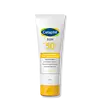What's inside
What's inside
 Key Ingredients
Key Ingredients

 Benefits
Benefits

 Concerns
Concerns

 Ingredients Side-by-side
Ingredients Side-by-side

Water
Skin ConditioningEthylhexyl Salicylate
UV AbsorberMethylene Bis-Benzotriazolyl Tetramethylbutylphenol
UV FilterBis-Ethylhexyloxyphenol Methoxyphenyl Triazine
Skin ConditioningDiethylhexyl Butamido Triazone
UV AbsorberButyl Methoxydibenzoylmethane
UV AbsorberC12-15 Alkyl Benzoate
AntimicrobialDibutyl Adipate
EmollientPentylene Glycol
Skin ConditioningAlcohol
AntimicrobialSorbitol
HumectantDimethicone
EmollientCetyl Phosphate
EmulsifyingCetyl Alcohol
EmollientTriethanolamine
BufferingTocopherol
AntioxidantDecyl Glucoside
CleansingLecithin
EmollientAcrylic Acid/Vp Crosspolymer
Propylene Glycol
HumectantXanthan Gum
EmulsifyingAloe Barbadensis Leaf Juice Powder
Skin ConditioningWater, Ethylhexyl Salicylate, Methylene Bis-Benzotriazolyl Tetramethylbutylphenol, Bis-Ethylhexyloxyphenol Methoxyphenyl Triazine, Diethylhexyl Butamido Triazone, Butyl Methoxydibenzoylmethane, C12-15 Alkyl Benzoate, Dibutyl Adipate, Pentylene Glycol, Alcohol, Sorbitol, Dimethicone, Cetyl Phosphate, Cetyl Alcohol, Triethanolamine, Tocopherol, Decyl Glucoside, Lecithin, Acrylic Acid/Vp Crosspolymer, Propylene Glycol, Xanthan Gum, Aloe Barbadensis Leaf Juice Powder
Octocrylene 8%
UV AbsorberHomosalate 6%
Skin ConditioningButyl Methoxydibenzoylmethane 3%
UV AbsorberAcrylates/C10-30 Alkyl Acrylate Crosspolymer
Emulsion StabilisingAloe Barbadensis Leaf Juice
Skin ConditioningCarbomer
Emulsion StabilisingCetearyl Alcohol
EmollientDisodium EDTA
Tocopheryl Acetate
AntioxidantGlycerin
HumectantGlyceryl Stearate
EmollientHydrated Silica
AbrasiveHydroxyacetophenone
AntioxidantAlcohol Denat.
AntimicrobialIsopropyl Palmitate
EmollientPhenoxyethanol
PreservativePolyglyceryl-3 Diisostearate
EmulsifyingPotassium Cetyl Phosphate
EmulsifyingWater
Skin ConditioningPvp
Emulsion StabilisingTriethanolamine
BufferingXanthan Gum
EmulsifyingOctocrylene 8%, Homosalate 6%, Butyl Methoxydibenzoylmethane 3%, Acrylates/C10-30 Alkyl Acrylate Crosspolymer, Aloe Barbadensis Leaf Juice, Carbomer, Cetearyl Alcohol, Disodium EDTA, Tocopheryl Acetate, Glycerin, Glyceryl Stearate, Hydrated Silica, Hydroxyacetophenone, Alcohol Denat., Isopropyl Palmitate, Phenoxyethanol, Polyglyceryl-3 Diisostearate, Potassium Cetyl Phosphate, Water, Pvp, Triethanolamine, Xanthan Gum
Ingredients Explained
These ingredients are found in both products.
Ingredients higher up in an ingredient list are typically present in a larger amount.
Also known as Avobenzone, this ingredient is a chemical sunscreen filter that provides protection in the UV-A range.
Avobenzone is globally approved and is the most commonly used UV-A filter in the world.
Studies have found that avobenzone becomes ineffective when exposed to UV light (it is not photostable; meaning that it breaks down in sunlight). Because of this, formulations that include avobenzone will usually contain stabilizers such as octocrylene.
However, some modern formulations (looking at you, EU!) are able to stabilize avobenzone by coating the molecules.
Avobenzone does not protect against the UV-B range, so it's important to check that the sunscreen you're using contains other UV filters that do!
The highest concentration of avobenzone permitted is 3% in the US, and 5% in the EU.
Learn more about Butyl MethoxydibenzoylmethaneTriethanolamine is an emulsifier and pH adjuster. It is created using ethylene oxide and ammonia. This gives Triethanolamine a nitrogen core and a similar scent to ammonia.
As an emulsifier, it prevents ingredients from separating and enhances texture by adding volume to a product.
PH adjusters are common in cosmetic products. The pH of a product can affect the effectiveness of other ingredients. A product with a high pH may also irritate the skin.
Learn more about TriethanolamineWater. It's the most common cosmetic ingredient of all. You'll usually see it at the top of ingredient lists, meaning that it makes up the largest part of the product.
So why is it so popular? Water most often acts as a solvent - this means that it helps dissolve other ingredients into the formulation.
You'll also recognize water as that liquid we all need to stay alive. If you see this, drink a glass of water. Stay hydrated!
Learn more about WaterXanthan gum is used as a stabilizer and thickener within cosmetic products. It helps give products a sticky, thick feeling - preventing them from being too runny.
On the technical side of things, xanthan gum is a polysaccharide - a combination consisting of multiple sugar molecules bonded together.
Xanthan gum is a pretty common and great ingredient. It is a natural, non-toxic, non-irritating ingredient that is also commonly used in food products.
Learn more about Xanthan Gum